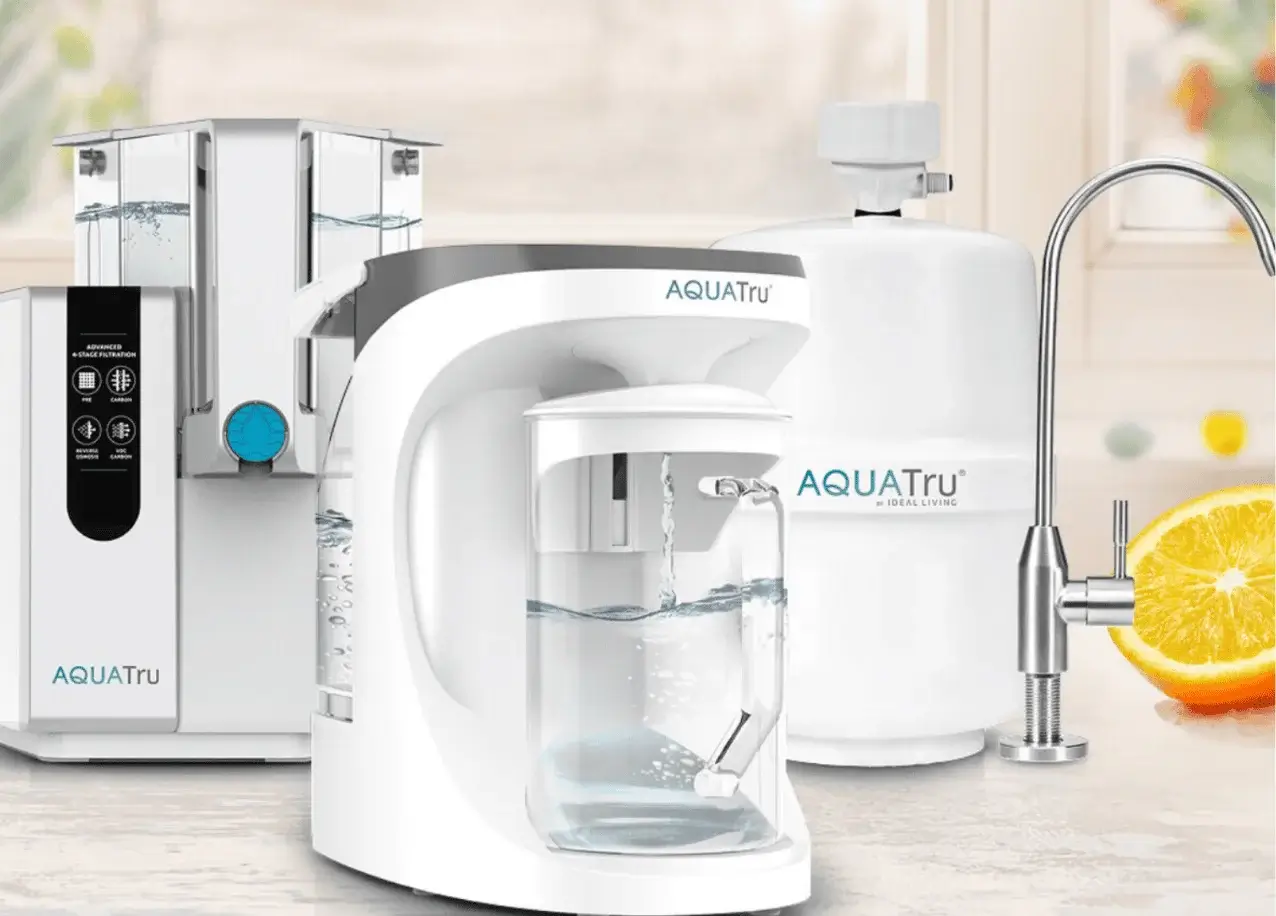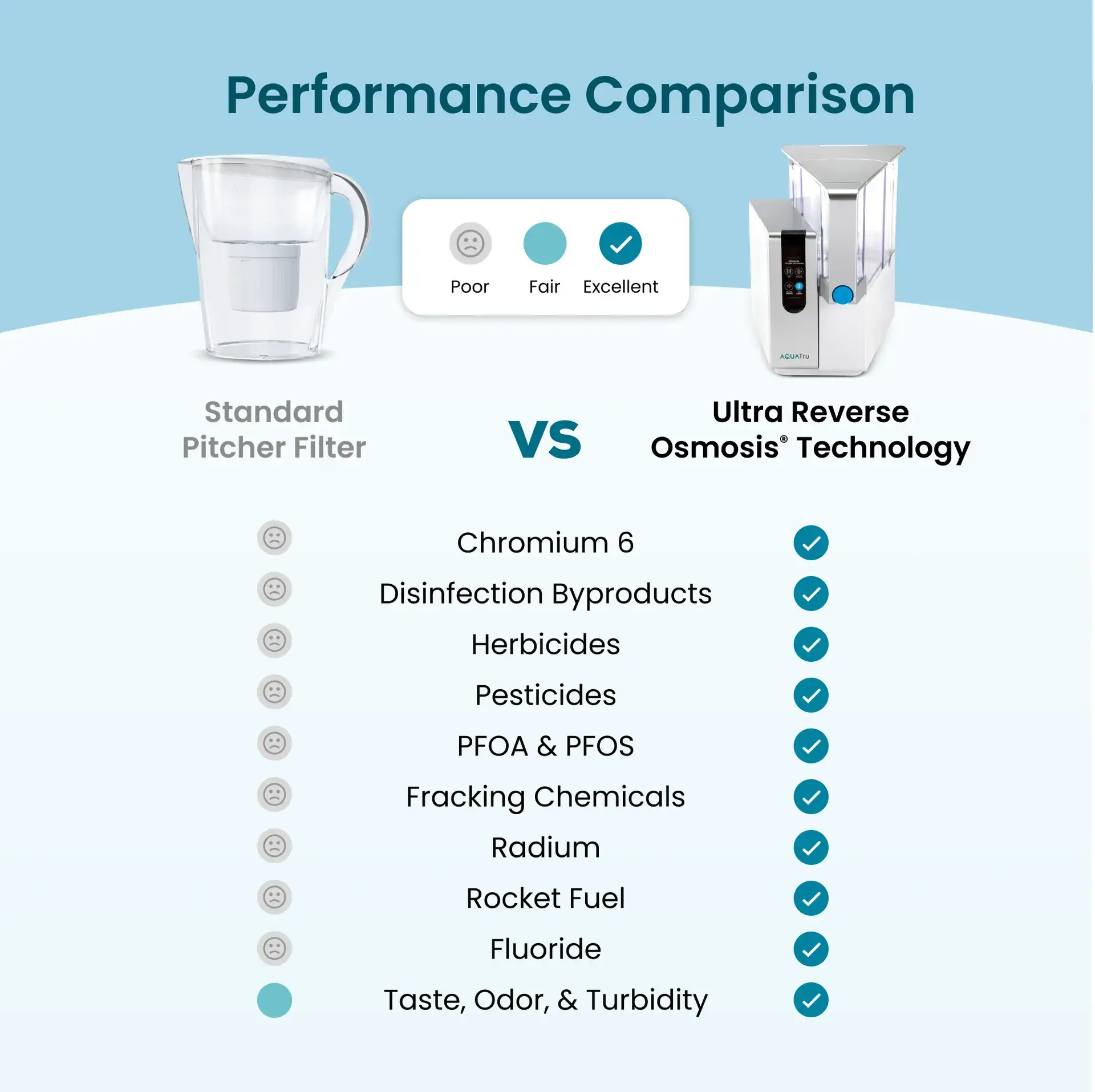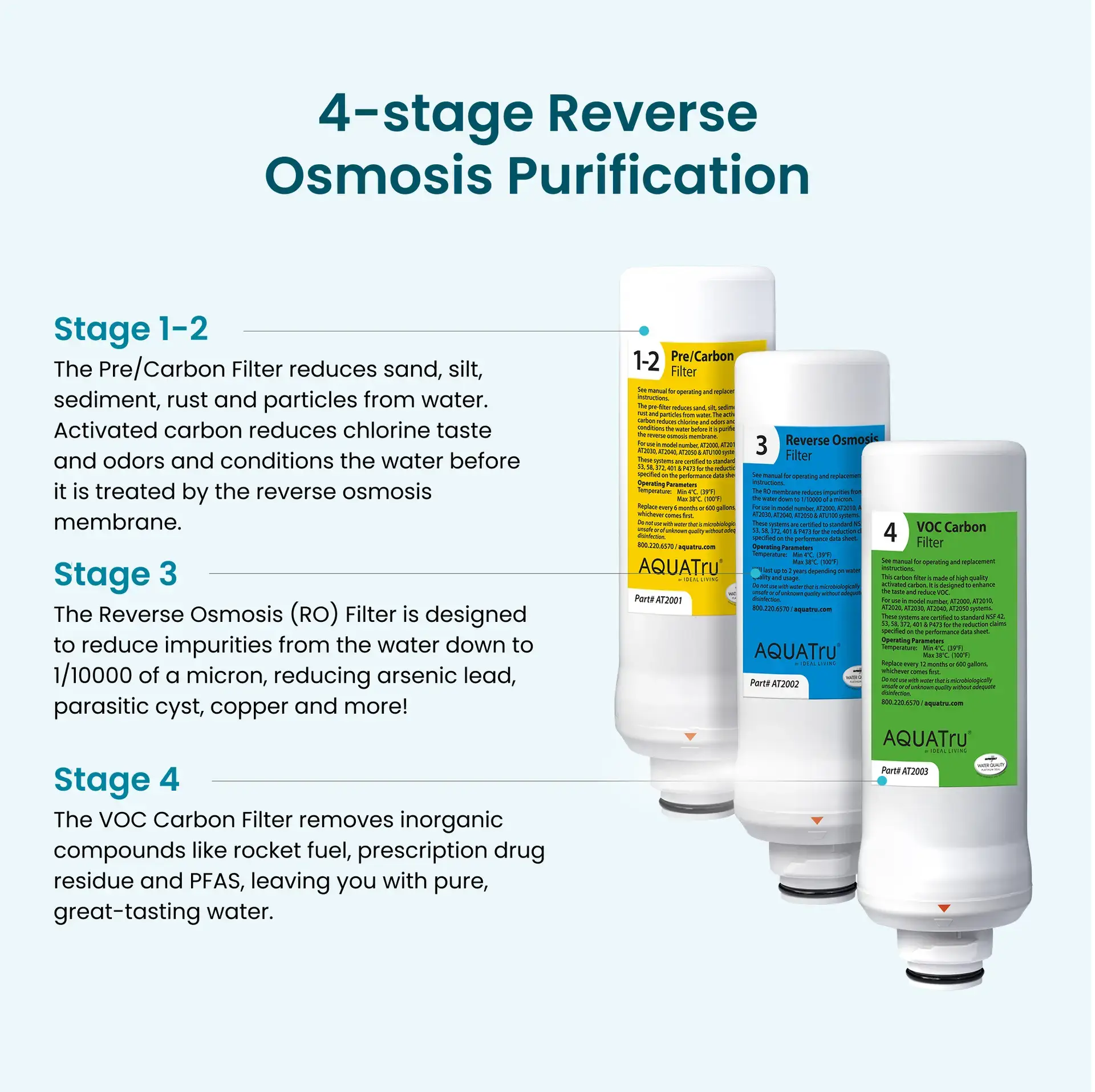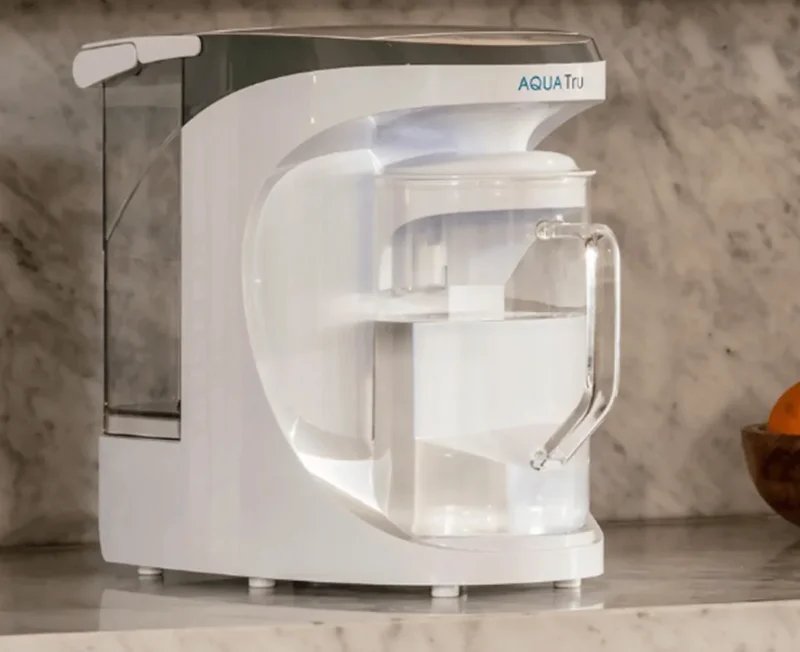One of the most common questions we get still is, “Is tap water safe to drink?”
Drinking water is among the most basic of needs for all living beings. Whether your water source is tap water, well water, bottled, filtered, or rainwater, follow along as we sort out the risks, myths, and facts of water safety. One myth is that people buy water purification devices based on the demonstrated safety they provide.
Public perceptions about municipal water systems have little to do with actual safety, and everything to do with culture and marketing, as this study shows. Sadly, convenience, cost, and taste are all more influential than health or environmental factors.
Table of Contents:
Is Tap Water Safe to Drink?
How bad could cold water straight from the tap be? If it tastes and looks OK it’s fine right? Well, maybe not.
We use water for drinking sure, but also in our homemade cleaning formulas, our essential oil DIYs, and as a basis for our body’s healing. Unfortunately, people and corporations are extremely careless with this most precious natural resource—as if it were unlimited in supply and easy to obtain.
Is tap water safe for drinking as is? Hardly.
In fact, truly safe drinking water is very rare. People who assume their public water systems make water safe can be at risk of exposure to dangers such as pathogens, heavy metals, and environmental toxins like forever chemicals and microplastics.
Systemic Water Problems Create Worldwide Issues
The theory that nothing happens in a vacuum is nowhere more true than when examining pesticide contamination of water supplies. A product designed to eliminate life, such as a pesticide or herbicide, continues to destroy life everywhere it goes. Unfortunately, this path of destruction water suppliers— for our children’s bathing water, our families’ cooking water, our infants’ bottles, everyone’s drinking water.
Water sanitation chemicals are usually meant to kill waterborne pathogens but does that mean tap water is safe?
Chlorine bleach is the chemical most frequently used to kill germs in water, although chloramine is becoming more popular and carries its own health risks. Although there are recommended limits to the amount of bleach remaining in water when it reaches the consumer, there are significant risks even at low levels.
The most common example of mass medication is fluoride in drinking water, ostensibly to reduce dental problems and strengthen bones, but fluoride is also used as an effective rat poison.
Pathogens in the Tap Water
Despite complex water treatment efforts, most drinking water arrives at your tap with some level of contaminants or pathogenic activity. The fact is, that as the earthly source of life, you can find many unpleasant microorganisms in drinking water, such as bacteria, viruses, parasites, and amoebas. They can grow readily in fresh water turning it from safe to quite dangerous in a short amount of time, especially at ambient temperatures. Other than occasional amoebic or parasitic infestation, bacteria like E. coli are the most frequent drinking water pathogens.
E. coli has become very common in recent years due to the numerous concentrated animal feeding operations (CAFOs) or factory farms springing up everywhere with extremely inhumane conditions that breed horribly filthy waste management practices, which, in turn, pollute public water supplies.
- According to this study, pathogens in water cause a wide range of extremely uncomfortable to outright deadly diseases such as gastroenteritis (vibrios, E. coli), cholera (vibrio cholerae), typhoid fever (salmonella), protozoan infection (giardiasis, cryptosporidiosis), and bacillary (shigella) or amoebic dysentery.
- Improved water sources offer some degree of protection, but according to this study cannot guarantee the water is free of fecal and other harmful contaminants. Water safety is not consistent among community water systems.
- Fungal contaminants often resist treatment according to this article and form a biofilm with bacteria and protozoa, making all three nearly impossible to kill.
- Even when treated by public water systems in first-world countries, people still get acutely ill on a frequent basis.
We’ve been using AquaTru since 2018. We love the taste, convenience and it’s super affordable. If you’re in the market for a water purifier, this is it! Get a special discount here because you’re a Natural Living Family reader!
Pesticides, Herbicide & Chemicals Pollutants in Our Water Systems
Harmful chemicals in household water generally fall into one of THREE categories: agricultural chemicals water sanitation chemicals, and environmental toxins.
Agri-chemicals, such as glyphosate-based herbicides (GBHs) enter groundwater, underground aquifers, and municipal water supplies nearly everywhere on Earth. Farmers who grow genetically modified crops (GMOs) rely heavily on GBHs to kill weeds, although Roundup, and the like, are also available to home gardeners.
They are grossly and irresponsibly overused to the point of pollinator extinction—that’s right, humankind is killing entire species like bees (and other pollinators) that are the only creatures capable of pollinating our crops—without them we will have no more food crops, and with these pesticides, we will have no more clean water. Other agricultural chemicals include fertilizer run-off containing nitrates and nitrites, and sometimes even banned chemicals such as DDT still in use.
Nitrate Pollution in Tap Water
Prenatal nitrate exposure doubles the incidence of birth defects such as cleft palate, limb deficiency, and cleft lip. Drinking water nitrate levels within the regulatory limit are associated with a greater risk of colon cancer and neural tube defects according to this research.
Atrazine and nitrate, even at low levels below the legal limits, are associated with very preterm delivery. According to one study they pose a serious danger to newborns and mothers.
Nitrate exposure from contaminated water can cause spina bifida, limb deficiency, cleft palate, cleft lip, neural tube defects, central nervous system defects, musculoskeletal defects, and congenital heart defects, according to this study. All at EPA-acceptable levels. This study shows links to bladder cancer.
Glyphosate & GBHs in Tap Water
This study shows that glyphosate and GBHs are found in groundwater, bottled water, and the urine of farm workers (even when used below the recommended limits). These harmful chemicals affect liver and muscle cells, chelating needed minerals from the body. From the groundwater, glyphosate also enters grains and legumes —it cannot be washed off because it enters the cellular structure.
THE MANY DANGERS OF GLYPHOSATES Glyphosate causes kidney and liver damage even at ultra-low doses. Glyphosate itself, with no co-formulants, is a teratogen at very low, supposedly safe levels, causing microcephaly and impairing reproductive development of male offspring with exposure anytime from the womb to puberty. It is associated with multiple myeloma, a non-Hodgkin’s lymphoma; the researcher who first presented this finding was pressured to recant despite damning evidence, but a later study confirms a significant link. It can cause diabetes and is implicated in neurodegenerative diseases including Parkinson’s disease.
Contrary to widespread claims of safety, glyphosate alone causes similar harm even at 1/3 the recommended concentration. Even though every co-formulant and GBH tested was found to be more toxic than glyphosate alone, they are excluded from sponsored studies in an attempt to hide or downplay the true danger. The actual potential for glyphosate harm highlighted in this systemic review has considerations beyond just glyphosate itself including:
- the presence of harmful co-formulants
- the effects of time amplification
- and bio-accumulation
The co-formulants are proven not to be inert as claimed, and the commercially available proprietary blends cause cell damage and death at the expected residual levels in water or food from GMO crops treated with GBHs. According to this abstract these formulations cause apoptosis and necrosis in human umbilical, placental, and embryonic cells.
Heavy Metals In Tap Water
Leard-contaminated water has been a concern for decades, and for good reason. Fortunately, when lead pipes were determined to be a major contributor to this problem, focused prevention efforts were made. Lead, however, is not the whole story. Your drinking water may contain other heavy metals or elements such as aluminum, cadmium, barium, and antimony. Arsenic in water is associated with low birth weight in this study.
Peace of mind. Great taste. No contaminates. We like the glass carafe model. Get your AquaTru here (NLF discount applied at checkout!
Microplastics in Tap Water
Microplastics are extremely small fragments of plastic, typically smaller than 5 millimeters. They originate from various everyday materials such as synthetic textiles, food packaging, and cosmetic products. As these materials degrade, they shed tiny plastic particles that eventually enter the environment. Over time, microplastics have been detected in oceans, freshwater sources, soil, and even inside drinking water systems.
Recent research has shown that a high percentage of tap water samples in the United States—up to 94%—contain microplastics. Because these particles are so small, conventional water treatment methods often fail to fully eliminate them. Early animal studies have linked microplastics to hormonal changes, inflammation, and organ damage. Although more research is needed to understand the risks for humans, their presence in places like the bloodstream and vital organs is cause for concern.
Fortunately, there are practical ways to reduce your family’s exposure. Boiling tap water followed by filtration, especially using systems like reverse osmosis or ultrafiltration, can significantly lower microplastic content. Replacing plastic containers with glass or stainless steel and minimizing overall plastic use at home can also help. Being proactive with these small changes supports a healthier, safer lifestyle.
“Forever Chemicals” in Tap Water
“Forever chemicals,” also known as PFAS (Per- and Polyfluoroalkyl Substances), are synthetic compounds used in a wide range of consumer products—from nonstick cookware and stain-resistant fabrics to fast food wrappers and firefighting foam. They’re designed to resist heat, grease, and water, which also makes them incredibly persistent in the environment.
Once these chemicals enter the water supply, they don’t easily break down. Instead, they accumulate over time—in soil, wildlife, and even the human body. Studies have linked long-term PFAS exposure to various health risks, including thyroid dysfunction, immune suppression, hormone disruption, and certain cancers.
For years, forever chemicals have been detected in our rain water. And testing consistently finds PFAS in drinking water systems across the country, raising alarms about their widespread impact.
Although removing these substances can be difficult, it’s not impossible. Home filtration options like reverse osmosis, activated carbon filters, and ion exchange systems have proven effective at reducing PFAS levels in tap water. As regulatory efforts continue to catch up with the science, individuals can take meaningful steps now to lower their exposure. Investing in proper water filtration is a smart and proactive way to support your family’s long-term health and reduce the burden of hidden contaminants.
What Drinking Water Sources are Available?
Does it make a difference regarding the source of water? Tap water, bottled water, delivered dispenser water, rainwater, and filtered water each carry their own inherent risks, but we all need to get our drinking water from somewhere. The following section outlines the benefits and risks of each water source.
Tap Water Facts
Unfiltered tap water provided by municipal water system, is low cost but is almost always has some level of contaminants. Watchdog groups such as the Environmental Working Group provide reports by zip code, highlighting any contaminants in drinking water from the previous quarter. Every class of water contaminant can be found in tap water, and water companies can continue to sell contaminated water to consumers as long as they publish their test results. This information is a great place to start when selecting a water filter, which we discuss in detail below.
Bottled Water vs Tap Water
The main benefit of bottled water is its convenience. It is easy to take them on the go and are able to be purchased at almost any stop. Unfortunately, bottled water has every possible downside because you can’t always be sure about sources, treatments, and storage containers. Bottled water generally begins as tap water.
This means it is subject to all the typical tap water contaminants, and not all are filtered or purified before bottling. Even those treated may leave sanitation chemical residues in the finished product. Finally, almost all bottled water is stored in plastic, and even the best plastic bottles do leach toxic chemicals into the water—the longer and warmer the storage conditions, the more dangerous. This discussion shows water bottles may leach aluminum, barium, and antimony into the water.
Is Delivered Dispenser Water Safe?
Water delivered in large (usually five-gallon) bottles for dispensers such as office water coolers is still technically bottled water. That means it’s subject to the same downsides as individual water bottles. Sometimes, however, it comes in glass rather than plastic, and often has higher quality sources or is treated with better filtration. Delivered water offers the ultimate convenience as it is brought directly to your door, and can be dispensed as steaming hot water, or chilled, but keep in mind—it is only as good as source, storage containers, and processing practices.
Is Drinking Well Water Safe?
Well water carries powerful associations for most people, and it’s important to understand the facts about well water when forming our opinions. Well water can be a viable alternative to community water systems because it is not subject to the water treatment chemicals that usually contaminate tap water. However, don’t assume that all well water is safe to drink. Contaminated by forever chemicals in the rain well water testing is crucial, especially in rural or agricultural areas. Agri-chemicals frequently end up in private wells, and depending on the well’s age, its sheathing, and its watershed, E. coli from pasture run-off is also a valid concern. Finally, if plumbed before lead pipe reform measures, the water must be tested for lead levels before drinking.
Is Drinking Rain Water Safe?
Like I shared above, rain water contains “forever chemicals” at this point, so the quick answer is ‘no,’ don’t drink rainwater. Given the dangers of contaminants in underground water sources, many people are renewing their interest in collecting rainwater. Naturally soft rainwater is super for soap-free washing and the taste is incomparable, according to its proponents. Extreme caution is needed.
Rainwater catchment systems are newly-illegal in many states and counties. In addition, those who drink rainwater should be aware of ever-increasing air pollutants such as dioxin and barium from factories and aircraft emissions. Other rainwater dangers include microbial activity from water stagnation, pests such as insects and rodents, leached toxins from roof/ collection surfaces, and chemical or heavy metal leaching from holding tanks and containers.
Is Drinking Spring Water Safe?
The safety and risks of spring water are generally similar to well water unless the spring water is bottled. Spring water is contaminated by forever chemicals in the rain and contaminated near the soil surface whereas wells, being deeper, face less groundwater contamination. In the case of bottled spring water, you need to consider that the term “spring water” is a marketing term that means the water emerges or springs from somewhere, frequently a public water tap. Almost all bottled spring water is simply tap water, with all its convenience and dangers.
The Fortunate Few Note that some people may have perfectly good well water or spring water, and do not need to take additional measures, but with air and ground water contamination spreading, frequent testing is needed to ensure that the safety of these sources has not been compromised.
We’ve been using AquaTru since 2018. We love the taste, convenience and it’s super affordable. If you’re in the market for a water purifier, this is it! Get a special discount here because you’re a Natural Living Family reader!
Is Tap Water Safe If I Filter it?
Filtered water begins with the same issues as tap water and so is only as good as the filtration and storage methods employed. Do you know how to purify tap water? This is not an exhaustive list, but the most common types of household water treatment products use methods such as reverse osmosis, ultra-violet light treatment, purification, mineralization, distillation, activated charcoal filtration, and ceramic / multi-media filtration.
Whole house filters are very convenient because they treat all the water coming into your home. To answer is tap water safe with absolute peace of mind this is the ideal. No tap water contaminants will negatively affect your home because all water is filtered—drinking, cooking, bathing, and irrigation. These systems generally use a series of textile media filters which are moderately effective at removing some common contaminants (not all) and may be quite expensive and require professional installation.
Tap mount (under/ above sink) filters treat drinking and possibly cooking water. Their effectiveness depends on the technology used, usually a textile media filter or reverse osmosis. This is a fiercely competitive market with many companies attempting to cash in on the great results of a few. In general, the true reverse osmosis filters are best for this application. While they are pricier than simple water pitchers, they are far less expensive than whole-house models.
The main downside is that your skin absorbs certain contaminants, like chlorine and chloramine, from a very brief shower than your gastrointestinal tract does from drinking a glass of water, so they may not be appropriate for eliminating chemical or chlorine exposure.
Reverse osmosis filters are among the best available, and the cost is midrange, resulting in a great value. Keep in mind that not all sink mount filters are true reverse osmosis, so do your research before investing. Reverse osmosis is highly effective at removing almost all contaminants. There is ongoing maintenance cost, depending on the model, and depending on the types of contaminants in your water, you may need to consider other options for your bathing and irrigation water.
Multi-media & ceramic filter purifiers are difficult to classify as quality varies significantly. Simple ceramic filters are a low-cost, effective solution for most households with few or minor contaminants. Because the elements rarely, if ever, need to be replaced, the cost-to-effectiveness ratio can eclipse other options. On the other hand, if there are many contaminants or more dangerous contaminants, a multi-media ceramic composite (such as the Berkey model) is needed.
Most composite ceramic elements are proprietary, so no blanket statement can be made regarding their effectiveness. The test results range from the Berkey brand, which is considered the gold standard for this type of water purifier to inexpensive copycat filters with no third-party testing at all. The top options in this category may, in fact, be the best solution overall; however, due diligence is needed in researching brands and testing because of the proliferation of copycat models that do comparatively little to improve water quality.
Water pitchers with activated charcoal filters are a popular and inexpensive option. The effectiveness of activated charcoal is not to be underestimated just because of its low cost and wide availability. Activated charcoal is so effective at absorbing toxins, that emergency rooms still use it in cases of ingested poison or drug overdose. These portable water filters can be effective. An activated charcoal filter can significantly improve almost all tap and well water.
That said, do not overestimate these filters either. They generally do not claim to remove all bleach or fluoride, only the associated odor and taste. That means they remove some level of contaminants, but generally not the 99.9% removed by the best water purifiers. If you look up your water test results on the EWG database, and find that contaminants are present, but not above legal limits, this option is perfectly adequate. It is also a great interim option for people considering more expensive purifiers or filters who feel compelled to take a first step to improve water quality immediately. Remember that almost all of these filters and the pitchers are plastic, and this introduces another set of potential contaminants. Carbon filters would fall in this category as well.
Commercial filtered water often uses ultra-violet light treatment to kill pathogens, so-called purification (which often means it is treated at a municipal water treatment facility and is the same as out of the tap), mineralization to add flavor, and distillation (which completely evaporates the water into steam, then reconstitutes it as pure water). It is almost invariably stored in plastic, practically guaranteeing leached toxins in the final product. Distilled and low-mineral waters impair bone quality (23) in females. Charcoal-filters reduce impurities yet maintains minerals.
This combination provides the best maternal and offspring outcomes (24). A pure natural water aquifer could provide similar benefits, but uncontaminated groundwater is nearly impossible to find due to widespread contamination by factory farming methods. When asking ourselves, is our tap water safe, we realize this is a global problem.
Special discount for NLF readers. Get your AquaTru today!
Healthy Water on the Go
Despite the convenience of instantaneous, inexpensive, portable, relatively clean water anywhere and everywhere, there is no longer any doubt about the consequences. Plastic water bottle pollution is overwhelming our planet.
And with microplastics now being detected in our brains, we want to steer clear of bottled water unnecessary.
The plastic water bottle nightmare. The sheer magnitude of the waste they become is significant even if they were not made from such a dangerous material. Even the safest plastics—PET plastic, comes with unacceptable health risks. Other plastics are even worse.
- Children of mothers reporting exclusive use of bottled water during pregnancy had significantly higher occurrences of neural tube defects , limb deficiencies, oral clefts, and heart defects.
- Even water bottled in PET bottles—considered the safest plastic—leach aluminum, barium, and antimony into the water, especially when stored at any temp above refrigeration (i.e. when stored at room temp during shipping, in the store, or at home); the higher the temp, the greater the danger—so NEVER drink from bottles left in a car, even for a short time. Even when chilled, these heavy metals and others leach into the water over time.
- Endocrine-disrupting chemicals are commonly found in bottled water.
Worse – the risks are not limited to just the people who drink from these bottles; the damage extends to plant and animal species long after we discard the empty bottles. We can learn by looking to the past. What did people do before plastic water bottles?
It seems most people assumed there was clean water available where they were going, so they only carried water on long trips or for work in fields away from a water source. Some used barrels, buckets, repurposed glass bottles, or mason jars to store or carry water when needed. No one expects you to keep a water barrel in the trunk of your car, but there are still safe, modern options available.
Better Water Bottle Choices
- Glass is still a safe, clean, and reliable option…if your kids don’t break it. It does not leach chemicals, is safe at any drinking water temperature, and you get green bonus points for taking the extra effort to find recycled glass bottles heavy enough to withstand daily use.
- Stainless steel may be the perfect blend of safety and durability. Like glass, it does not leach toxins or become unsafe at room temperature, but unlike glass, it does not break. Even if your children put them through the rigors of summer sports, lockers, and drops down the stairs, they will still have perfectly functional water bottles. Find a reputable manufacturer as many so-called stainless bottles from foreign manufacturers contain high levels of aluminum, and some fully aluminum bottles are mislabeled as stainless steel.
And let’s debunk the myth: bottled water is NOT the most cost-effective way to significantly improve your drinking water.
Assuming you don’t live in Fiji with the purest water on Earth flowing out of the ground at your feet, the lowest cost method to make a huge impact on drinking water quality is probably to repurpose a glass bottle with a screw top lid as your new daily water bottle and buy an AquaTru countertop unit. The filters last a long time and you’ll save a ton of money on plastic bottled water.
Pitcher Vs. RO Comparison
A picture says a 1,000 words, right? Let this graphic sink in for a moment…
When it comes down to standard pitcher filter and Ultra Reverse Osmosis Tech, there is no comparison.
Revolutionary Water Purification AquaTru water purifiers use patented 4-Stage Reverse Osmosis purification that transforms your tap water into pure, delicious, clean water you can trust. Certified to remove 84 contaminants, including:
- ‘Forever chemicals’ (PFOA & PFOS)
- Microplastics
- Fluoride
- Chlorine
- Lead
- Chromium 6
- Arsenic
- Nitrates Pesticides & Herbicides
It takes out everything, but the water, which is exactly what you need.
Don’t worry about minerals or anything in your water. Tap water is so void of anything healthy for us that you want the cleanest water possible. You can easily supplement with electrolytes (and here are some of our favs).
AquaTru’s Patented 4-Stage Ultra Reverse Osmosis® Purification technology is 80% more efficient than traditional reverse osmosis (R.O.) systems. It recirculates water and concentrates contaminants in the tap water tank—resulting in more water filtered and less waste.
Step 1 & 2: Pre/Carbon Filter—A mechanical Pre-Filter captures larger particles like sediment and rust, while a Carbon Filter removes chlorine and chloramines for cleaner, better-tasting water.
Stage 3: Reverse Osmosis Filter—An ultra-fine R.O. filter eliminates harmful inorganic chemicals, including lead, microplastics, chromium-6, arsenic, nitrates, and heavy metals.
Stage 4: VOC Carbon Filter—A coconut shell carbon block filter reduces volatile organic compounds (VOCs), including rocket fuel, prescription drug residue, and “forever chemicals” (PFOS & PFOA)—leaving you with pure, great-tasting water.
An eco-friendly side-effect of using AquaTru is customers have prevented over 2 billion single-use plastic bottles from polluting landfills and waterways. With AquaTru, you’re making a difference—one pure sip at a time. In just 6 months, their Classic Countertop Purifier saves 4,500 plastic bottles —a small switch with a big impact. #reducingmicroplastics
To recap…
AquaTru’s line of water purifiers utilize patented Ultra Reverse Osmosis® technology, independently tested to meet NSF standards. That means AquaTru isn’t just any filter; it’s a powerhouse at eliminating harmful contaminants while preserving everything you love about fresh, clean water.
- No nanoplastics.
- No heavy metals.
- No ‘forever chemicals’
- No heavy metals
- No chlorine
Finally, buy each member of your household a glass or stainless steel water bottle, fill it with filtered water before you leave the house, and you will always have clean water handy on the go. This covers all the bases, and results in the cleanest water available in every application. Once you detox your water, learn how to detox the rest of your house!
NLF “Group Buy” – Exclusive Discount!
As part of our partnership with AquaTru, you get access to the best price on portable, effective, reverse osmosis water filtration products you can use right out of the box (no plumper required.
Just pure, refreshing hydration. Long lasting, easy to change filters. No installation or plumbing required on Classic or Carafe units
With so many health benefits of drinking pure, clean water, you won’t want to miss saving with a Hour Natural Living Family ‘group buy’ discount today!
- https://www.ncbi.nlm.nih.gov/pmc/articles/PMC2714301/
- https://www.ncbi.nlm.nih.gov/pmc/articles/PMC2996186/
- https://www.ncbi.nlm.nih.gov/pmc/articles/PMC4011876/
- https://www.ncbi.nlm.nih.gov/pmc/articles/PMC5486322/#sec5-ijerph-14-00636title
- https://www.ncbi.nlm.nih.gov/pmc/articles/PMC4823834/#sec5title
- https://pubmed.ncbi.nlm.nih.gov/23771435/
- https://pubmed.ncbi.nlm.nih.gov/27816866/
- https://www.ncbi.nlm.nih.gov/pmc/articles/PMC3764078/
- https://www.ncbi.nlm.nih.gov/pmc/articles/PMC5089883/
- https://www.ncbi.nlm.nih.gov/pmc/articles/PMC5486281/
- https://pubmed.ncbi.nlm.nih.gov/14971683/
- https://pubmed.ncbi.nlm.nih.gov/15626647/
- https://www.ncbi.nlm.nih.gov/pmc/articles/PMC2628921/
- https://pubmed.ncbi.nlm.nih.gov/19105591/
- https://pubmed.ncbi.nlm.nih.gov/24304547/
- https://pubmed.ncbi.nlm.nih.gov/28714553/
- https://pubmed.ncbi.nlm.nih.gov/28604590/
- https://pubmed.ncbi.nlm.nih.gov/25645381/
- https://www.ncbi.nlm.nih.gov/pmc/articles/PMC4652143/
- https://pubmed.ncbi.nlm.nih.gov/24713268/
- https://www.ewg.org/tapwater/#.W2EmFNJKjIV
- https://www.ncbi.nlm.nih.gov/pmc/articles/PMC4245802/#Sec4title
- https://www.ncbi.nlm.nih.gov/pmc/articles/PMC4372292/
- https://www.ncbi.nlm.nih.gov/pmc/articles/PMC4184831/#idm140307755967744title
- https://pubmed.ncbi.nlm.nih.gov/25473985/
- https://www.ncbi.nlm.nih.gov/pmc/articles/PMC3756062/
- https://www.ncbi.nlm.nih.gov/pubmed/16263519
- https://www.ncbi.nlm.nih.gov/pmc/articles/PMC4549093/
- https://www.ncbi.nlm.nih.gov/pmc/articles/PMC1253709/
- https://www.ncbi.nlm.nih.gov/pubmed/22120950
- https://www.ncbi.nlm.nih.gov/pmc/articles/PMC5370400/#__sec13title
- https://www.ncbi.nlm.nih.gov/pmc/articles/PMC3084150/
- https://www.ncbi.nlm.nih.gov/pubmed/29107351












